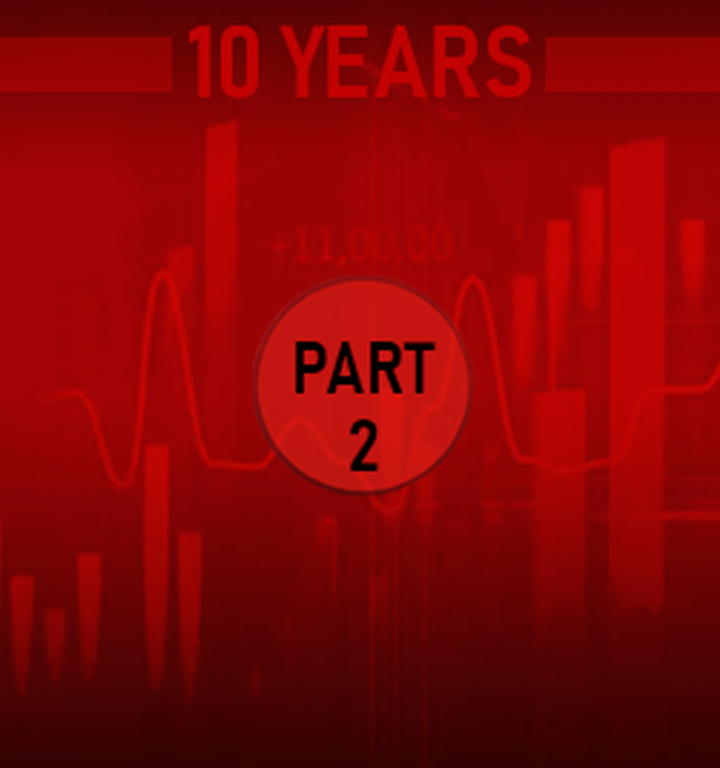
View Expert Insights
March • 5 • 2021
Insights from 10 Years of Malpractice Claims Data Part II: Top Specialty Analysis
Article
Summary
Coverys’ special report, A Call for Action: Insights From a Decade of Malpractice Claims, examines data derived from 11,000+ events pertaining to 20,000+ closed claims across a 10-year period (2010 to 2019). This is the second of a five-part blog series based upon the report.
Demands on physicians are burdensome and widely known. Burnout is widespread and rising. Factors include the influence of health information technology, production pressures, and overall reduction in workplace satisfaction.
These influences are persistent despite efforts from the National Academy of Medicine and many local initiatives to provide resources to help physicians deliver safe, effective care and stay healthy. Our data shows these efforts are not necessarily having the desired impact. One exception is anesthesiology, which serves as an example of how data can be used to drive change.
Physician practice over time has become increasingly specialized. Claims rates and indemnity paid for top specialties and a selection of medical sub-specialists is provided below.
Anesthesiology
The practice of anesthesia is now highly data-driven, and claims are declining. A focus on simulation training, human factors engineering, and evidence-based decision-making has resulted in improvements.
The overall claims rate was reduced significantly from an average of 4.9 claims per 100 physicians in the first five years analyzed to 3.2 per 100 in the last five years.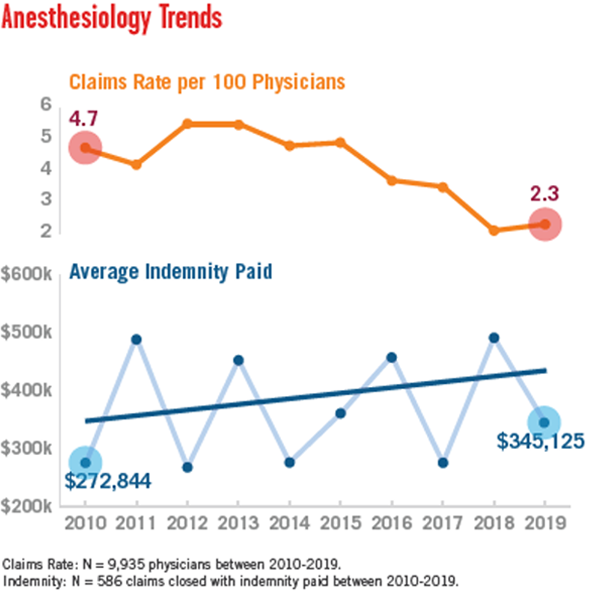

Data derived from 11,907 events pertaining to 20,211 closed claims at Coverys across a 10-year period from 2010 to 2019. Coverys. (2020). A call for action: Insights from a decade of malpractice claims. https://www.coverys.com/PDFs/call-for-action-decade-of-malpractice-claims.aspx
Emergency Medicine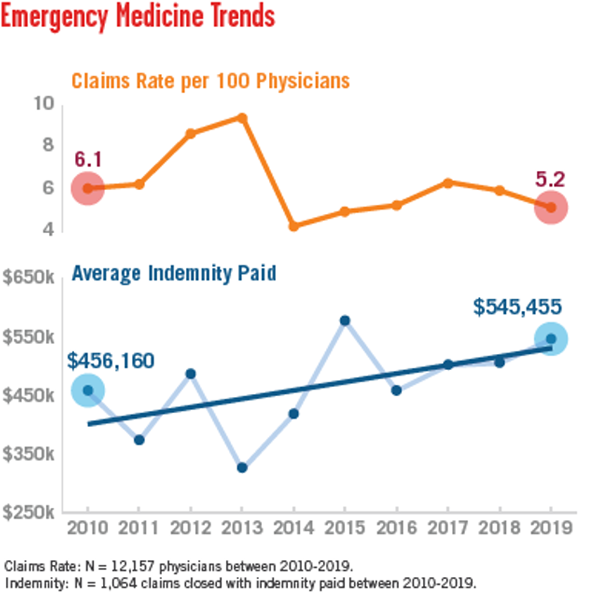

Data derived from 11,907 events pertaining to 20,211 closed claims at Coverys across a 10-year period from 2010 to 2019. Coverys. (2020). A call for action: Insights from a decade of malpractice claims. https://www.coverys.com/PDFs/call-for-action-decade-of-malpractice-claims.aspx
General Medicine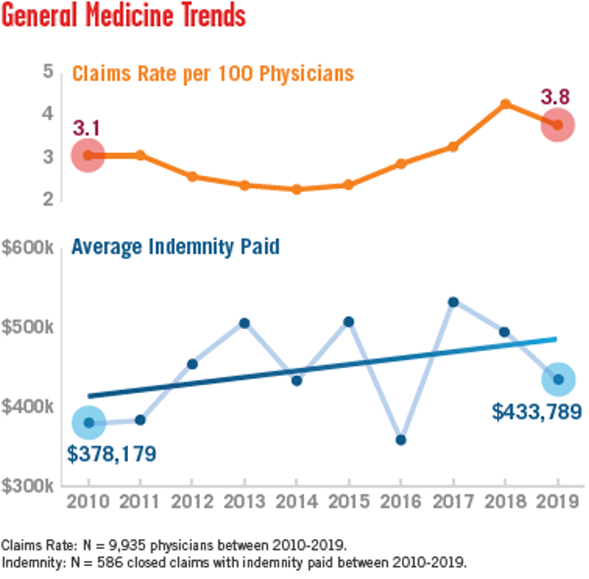

Data derived from 11,907 events pertaining to 20,211 closed claims at Coverys across a 10-year period from 2010 to 2019. Coverys. (2020). A call for action: Insights from a decade of malpractice claims. https://www.coverys.com/PDFs/call-for-action-decade-of-malpractice-claims.aspx
Obstetrics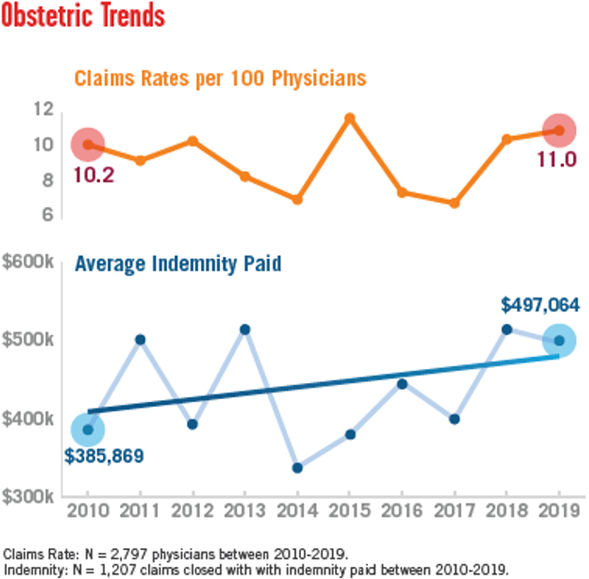

Data derived from 11,907 events pertaining to 20,211 closed claims at Coverys across a 10-year period from 2010 to 2019. Coverys. (2020). A call for action: Insights from a decade of malpractice claims. https://www.coverys.com/PDFs/call-for-action-decade-of-malpractice-claims.aspx
Radiology

Data derived from 11,907 events pertaining to 20,211 closed claims at Coverys across a 10-year period from 2010 to 2019. Coverys. (2020). A call for action: Insights from a decade of malpractice claims. https://www.coverys.com/PDFs/call-for-action-decade-of-malpractice-claims.aspx
Surgery


Data derived from 11,907 events pertaining to 20,211 closed claims at Coverys across a 10-year period from 2010 to 2019. Coverys. (2020). A call for action: Insights from a decade of malpractice claims. https://www.coverys.com/PDFs/call-for-action-decade-of-malpractice-claims.aspx
For more detailed information including: top claim trends, claim trends by specialty (including allegations, injury severity, location), persistent and emerging risks, and top risk management issues, access the full report: A Call for Action: Insights From a Decade of Malpractice Claims.
These influences are persistent despite efforts from the National Academy of Medicine and many local initiatives to provide resources to help physicians deliver safe, effective care and stay healthy. Our data shows these efforts are not necessarily having the desired impact. One exception is anesthesiology, which serves as an example of how data can be used to drive change.
Top Specialty Analysis
Physician practice over time has become increasingly specialized. Claims rates and indemnity paid for top specialties and a selection of medical sub-specialists is provided below.Anesthesiology
The practice of anesthesia is now highly data-driven, and claims are declining. A focus on simulation training, human factors engineering, and evidence-based decision-making has resulted in improvements.
The overall claims rate was reduced significantly from an average of 4.9 claims per 100 physicians in the first five years analyzed to 3.2 per 100 in the last five years.
- Anesthesiologists aged 55 to 64 have a higher rate of claims than other age groups.
- Although average indemnity and expense payments have been increasing, indemnity payouts have varied considerably from year to year.
- The average rate of claims with indemnity paid was 21%.


Data derived from 11,907 events pertaining to 20,211 closed claims at Coverys across a 10-year period from 2010 to 2019. Coverys. (2020). A call for action: Insights from a decade of malpractice claims. https://www.coverys.com/PDFs/call-for-action-decade-of-malpractice-claims.aspx
Emergency Medicine
- The claims rate is declining for emergency medicine physicians.
- The claims rate for emergency physicians aged 45 and older decreased significantly.
- The rate of claims with indemnity paid was 20% over 10 years with a significant decline in 2019 to 15%.
- Average indemnity and expenses increased with average claims expenses slightly more than $41,000 over the 10-year period.


Data derived from 11,907 events pertaining to 20,211 closed claims at Coverys across a 10-year period from 2010 to 2019. Coverys. (2020). A call for action: Insights from a decade of malpractice claims. https://www.coverys.com/PDFs/call-for-action-decade-of-malpractice-claims.aspx
General Medicine
- The claims rate for general medicine (Coverys’ largest insured base) has trended upward due to higher claims counts in recent years, including a spike in 2018.
- Average gross paid indemnity per claim increased, with a 10-year average of approximately $449,000.
- The number of claims with indemnity paid have remained relatively flat, averaging 23% over the 10-year period. Average expenses are also relatively flat despite significant yearly variations.


Data derived from 11,907 events pertaining to 20,211 closed claims at Coverys across a 10-year period from 2010 to 2019. Coverys. (2020). A call for action: Insights from a decade of malpractice claims. https://www.coverys.com/PDFs/call-for-action-decade-of-malpractice-claims.aspx
Obstetrics
- Claims frequency increased slightly from an average of 9.1 claims per 100 physicians in the first five years to 9.5 in the last half of the 10-year period.
- The highest rate of obstetric claims are experienced by physicians in the 35–44 age range.
- Both average indemnity and expenses are increasing with average indemnity per claim over 10 years at $435,447.
- The rate of claims with indemnity paid was 32% across the 10-year period, which is basically flat but higher than for other types of claims.


Data derived from 11,907 events pertaining to 20,211 closed claims at Coverys across a 10-year period from 2010 to 2019. Coverys. (2020). A call for action: Insights from a decade of malpractice claims. https://www.coverys.com/PDFs/call-for-action-decade-of-malpractice-claims.aspx
Radiology
- The claims rates for radiologists are decreasing.
- Radiologists tend to be sued less frequently after age 54.
- Average expenses and indemnity payouts for radiologists have increased.
- The rate of claims with indemnity paid was 27%.


Data derived from 11,907 events pertaining to 20,211 closed claims at Coverys across a 10-year period from 2010 to 2019. Coverys. (2020). A call for action: Insights from a decade of malpractice claims. https://www.coverys.com/PDFs/call-for-action-decade-of-malpractice-claims.aspx
Surgery
- The claims rate per 100 surgeons is on a downward trend, with an average of 12.4 claims per 100 physicians during 2010 to 2014. This lowered to 9.7 from 2015 to 2019.
- The highest claims rates are attributed to physicians 35 to 44 years of age.
- Indemnity payouts for surgery claims are increasing, as are expenses.
- The rate of claims with indemnity paid was 25%.



Data derived from 11,907 events pertaining to 20,211 closed claims at Coverys across a 10-year period from 2010 to 2019. Coverys. (2020). A call for action: Insights from a decade of malpractice claims. https://www.coverys.com/PDFs/call-for-action-decade-of-malpractice-claims.aspx
For more detailed information including: top claim trends, claim trends by specialty (including allegations, injury severity, location), persistent and emerging risks, and top risk management issues, access the full report: A Call for Action: Insights From a Decade of Malpractice Claims.
Copyrighted. No legal or medical advice intended. This post includes general risk management guidelines. Such materials are for informational purposes only and may not reflect the most current legal or medical developments. These informational materials are not intended, and must not be taken, as legal or medical advice on any particular set of facts or circumstances.